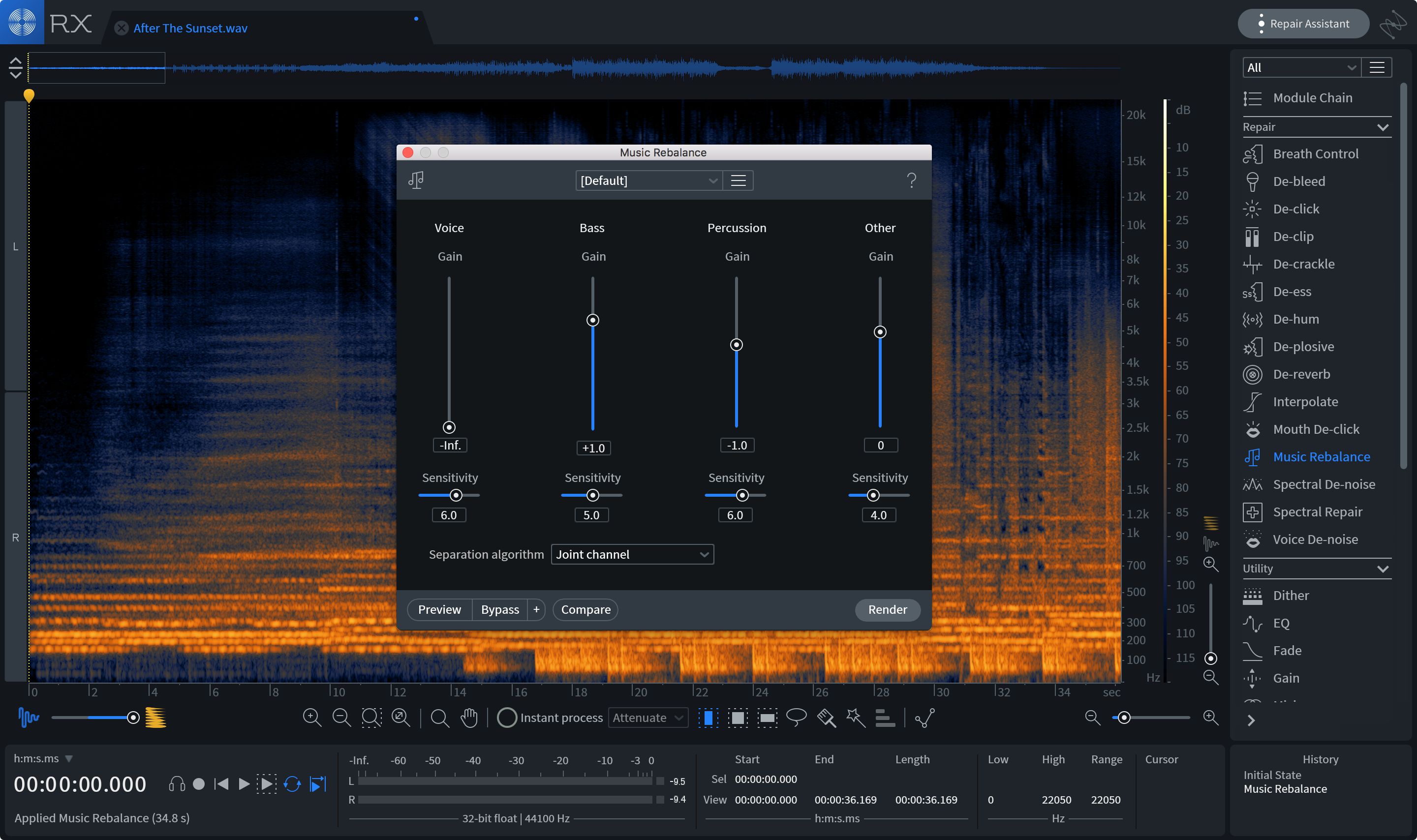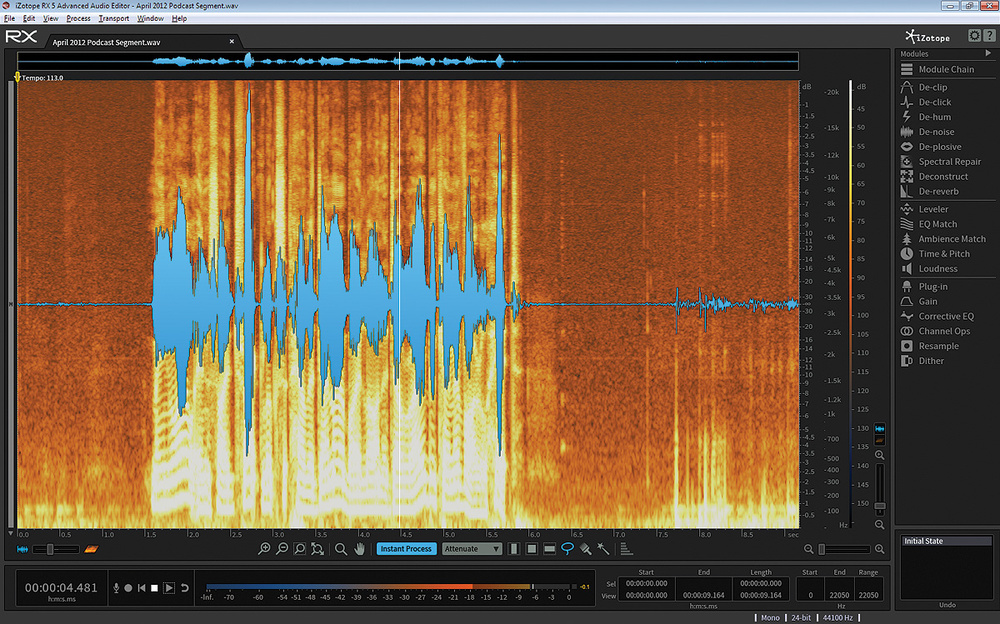Izotope Rx 5 Audio Editor Tutorial

It seems that along with Christmas, another regular annual event we can rely upon is a new version of iZotope’s RX Audio Editor software. Incorporating an ever-expanding collection of sophisticated tools for repairing, restoring and enhancing audio files, RX has now reached version 5, with both standard and Advanced editions available. 5 Creative Uses of iZotope RX in Audio Mastering Automation in the Audio Mastering World: Leveling up Your Ozone 8 Skills with Tasteful Automation How to Master an Album, and More Audio Mastering Questions Answered.
iZotope has released RX 5 Audio Editor, a significant upgrade to their well-stocked toolbox of audio repair software modules (previously at v4). RX 5 adds a number of new repair modules, and brings considerable enhancements to many of its tools, along with additional features that offer greater efficiency and better integration with DAWs.
As before, RX 5 comes in two versions—RX 5 Audio Editor, the standard version (for budget-conscious users) and the more full-featured RX 5 Advanced Audio Editor, which includes additional high-end processing tools (for a full comparison, check the iZotope website and downloadable manual). RX 5 comes as both a standalone application, chock full of processing “modules”, and as a suite of plug-ins in all the standard formats. Both the standard and Advanced versions offer new goodies—some modules (DeReverb) that were previously available only in the Advanced version are now included in the standard version, and certain functions that were standalone-only (Ambience Match) are now available as (AudioSuite) plug-ins as well. For the full list of processing modules in RX 5 Advanced, see Fig 1.
Besides being available as an individual purchase, RX5 Advanced is available as part of iZotope’s new RX Post Production Suite, along with several other tools for handling tasks specific to post-production workflows. The Suite also includes RX Final Mix—a dedicated EQ/Dynamics plug-in intended for use on audio stems in video production (dialog/FX/music). And there’s Insight, iZotope’s comprehensive metering suite, and RX Loudness Control, which automates the task of conforming to broadcast industry standards for loudness. RX 5 Advanced adds its many audio repair tools to these dedicated post-production processors—while they do wonders for music tracks, they’re especially valuable for cleaning up audio in post situations, like problematic location recordings (leakage) or classic dialog issues (ambience, plosives, breaths, etc.).
One of the main areas of improvement has been in workflow efficiency—this takes two forms. Options for automatic processing have been enhanced, resulting in less need for experimenting with settings—many modules that I remember had required a bit more fiddling in the past now seem to get the job done more quickly, with default settings. And workflow can be more streamlined, thanks to features like Instant Processing (of selections) and RX Connect, which makes it easier to bring audio in from the DAW for processing, and send the repaired audio back to the DAW.
Naturally, all of the modules from previous versions of RX are there, and I won’t spend time describing those in any detail—I’ll just focus in on a few of the latest & greatest features.
No Waiting
Of course, RX 5 includes the Spectral Processing (and Deconstruct) modules, which let you graphically select and extract unwanted sound from audio waves, like a pedal squeak in a music track, or a passing siren on a dialogue recording. Now there’s a new mode—Instant Process. Normally, you’d select the unwanted sound in RX’s spectrogram display, select the appropriate module, and process. But if you have a longer recording that has a number of instances of the same problem, you can enable Instant Process, choose the desired processing (from the adjacent popup menu), and now the audio will be processed immediately as you complete each selection, using the current settings for the chosen module (Fig 2).
Fig 2 RX 5’s Instant Process feature (applied to Spectral Repair).
Audio Example 1—RX 5 removes unwanted sound/leakage from two recordings with Spectral Repair via Instant Process mode:
I found that this could really speed things up, especially with repetitive problems, once you’ve determined appropriate settings that work consistently for particular issues.
Chain of tools
RX 5’s new Module Chain feature lets you set up a processing chain of several modules, with specific settings for each module in the chain, save this particular configuration as a preset, and then call it up for quick and efficient application of multiple processing.
The modules in a chain have their own unique settings for that chain, independent of the last (default) settings used for them when they were opened up from the main list on the right. Like with Instant Processing, this can be a great time saver for recurring edits, especially useful for dialog editing, where a number of typical dialog issues (pops, breaths, “s”s, clips, room tone, etc.) can be dealt with in a single pass. Again, the key is to save and use a preset with the most appropriate settings for the particular recording(s) you’re dealing with, but as I noted before, the default settings for many of these modules seem to do the trick even without further tweaking.
Muzzle that vocal
Two of the most persistent issues, when it comes to vocal and dialog recordings, are sibilance (harsh “s”s) and breath noises. RX 5’s Leveler module now lets you enable automatic handling for both of these, with depth settings for each (again, I found the defaults often worked best). The algorithms identify any problem sibilance and breaths, and make quick work of those flaws, eliminating the need for separate EQ & gating, and cleaning up even a lengthy recording with a single click—a highly useful tool, for both music and post.
Fig 4 The Dialog Leveler, set to fix excessive sibilance (Ess Reduction) and breath sounds (Breath Control).
Izotope Rx 2 Free Download
Pop goes the module
One of the most annoying flaws in a vocal track can be microphone plosives—those loud thumps that often occur on the letters “p” and “b”—a.k.a. “p-pops”. The new De-Plosive module may not be the flashiest new toy in RX 5’s arsenal, but it can be one of the most welcome. P-pops often require a tedious series of edits or a sometimes dubious application of filtering to get rid of them, but De-Plosive handles all the heavy lifting seamlessly. I’ve often had to address fairly lengthy dialog or vocal recordings with multiple p-pops—especially live vocal tracks made with a hand-held mic—and De-Plosive would have been a godsend. As with many of the new tools, it required little or no fussing with settings—it succeeded on everything I tried it on pretty much out of the box.
Fig 5 The De-Plosive module makes short work of those pesky p-pops (before (top) & after (bottom) processing).
Audio Example 2—A recording with plosives (p-pops) repaired by RX 5’s De-Plosive module:
Omnisphere 2. 5 free reddit download. Get an ad-free experience with special benefits, and directly support Reddit. Get reddit premium. Clouxtboii47; about moderation team » discussions in u/clouxtboii47 X. 5 20 comments. Omnisphere 2 download link (Working) Welcome to Reddit, the front page of the internet. REDDIT and the ALIEN Logo are registered.
Wrap-up
There are plenty of other enhancements in RX 5 and RX 5 Advanced, but that’s all I have room for here. Whether your area is music or post-production, this swiss army knife collection of tools should be able to handle any problems you throw at it, and this latest version does so with even greater ease and efficiency than ever—definitely a must-have for any serious audio engineer’s toolbox.
Price: RX 5: $349; RX 5 Advanced: $1,199; RX Post Production Suite (incl RX 5 Adv): $1,499
Pros: An incredibly comprehensive and effective suite of audio repair processors that can address almost any task.

Izotope Rx Free Trial
Cons: Advanced version is a bit pricey, though it does include a number of very useful extras.
Izotope Rx 5 Audio Editor Tutorial For Beginners
Web:https://www.izotope.com/en/products/post-production/rx-5-audio-editor/
Video Course:RX Audio Repair for Musicians
Here's a video from the course, RX Repair for Musicians, showing how to remove AC hum and buzz from an audio recording: